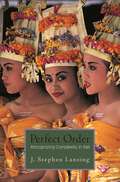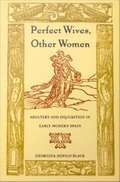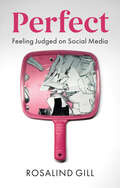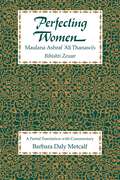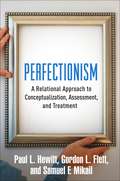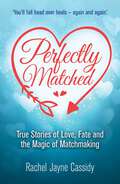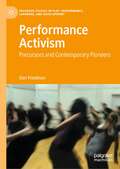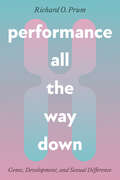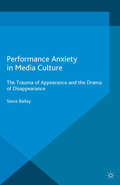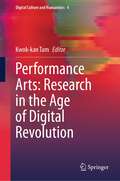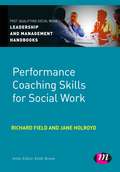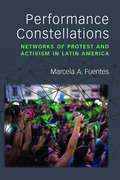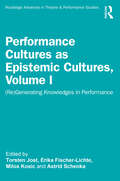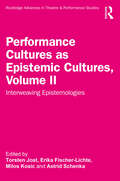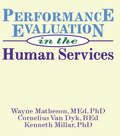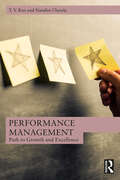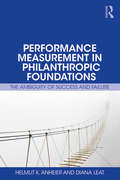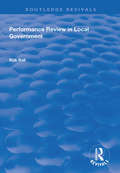- Table View
- List View
Perfect Order: Recognizing Complexity in Bali (Princeton Studies in Complexity #11)
by J. Stephen LansingAlong rivers in Bali, small groups of farmers meet regularly in water temples to manage their irrigation systems. They have done so for a thousand years. Over the centuries, water temple networks have expanded to manage the ecology of rice terraces at the scale of whole watersheds. Although each group focuses on its own problems, a global solution nonetheless emerges that optimizes irrigation flows for everyone. Did someone have to design Bali's water temple networks, or could they have emerged from a self-organizing process? Perfect Order--a groundbreaking work at the nexus of conservation, complexity theory, and anthropology--describes a series of fieldwork projects triggered by this question, ranging from the archaeology of the water temples to their ecological functions and their place in Balinese cosmology. Stephen Lansing shows that the temple networks are fragile, vulnerable to the cross-currents produced by competition among male descent groups. But the feminine rites of water temples mirror the farmers' awareness that when they act in unison, small miracles of order occur regularly, as the jewel-like perfection of the rice terraces produces general prosperity. Much of this is barely visible from within the horizons of Western social theory. The fruit of a decade of multidisciplinary research, this absorbing book shows that even as researchers probe the foundations of cooperation in the water temple networks, the very existence of the traditional farming techniques they represent is threatened by large-scale development projects.
Perfect Soldiers: The 9/11 Hijackers
by Terry McDermott“The definitive book on the nineteen men who brought such devastation and terror to this country . . . a well-told, meticulously researched cautionary tale.” —Washington Post Book WorldThe attacks of September 11, 2001, were a calamity on a scale few had imagined possible. In their aftermath, we exaggerated the men who perpetrated the attacks, shaping hasty and often mistaken reporting into caricatures we could comprehend—monsters and master criminals equal to the enormity of their crime. In reality, the 9/11 hijackers were unexceptional men, not much different from countless others. It is this ordinary enemy, not the caricature, that we must understand if we are to have a legitimate hope of defeating terrorism.Using research undertaken in twenty countries on four continents, Los Angeles Times correspondent Terry McDermott provides gripping, authoritative portraits of the main players in the 9/11 plot. With brilliant reporting and thoughtful analysis, McDermott brings us a clearer, more nuanced, and in some ways more frightening, understanding of the landmark event of our time.“The very best [book] available . . . on the subject.” —Los Angeles Times“Absorbing. . . . [A] richly textured narrative full of the sort of small, telling details that turn these men from faceless figures of evil into individuals.” —New York Times“Bound to become one of the most insightful books ever published about September 11.” —Houston Chronicle“Offers riveting accounts of the final weeks and days as the plotters prepared to carry out their horrific mission.” —Booklist“Chilling.” —KirkusReviews“This is journalism at its best.” —Seymour M. Hersh, Pulitzer Prize winning journalist“Engrossing and deeply disturbing.” —Publishers Weekly
Perfect Tunes
by Emily GouldThe perfect song. The biggest dream. The love of her life. It’s the early days of the new millennium, and Laura has arrived in New York City’s East Village in the hopes of recording her first album. A songwriter with a one-of-a-kind talent, she’s just beginning to book gigs with her beautiful best friend when she falls hard for a troubled but magnetic musician whose star is on the rise. Their time together is stormy and short-lived – but will reverberate for the rest of Laura’s life. Fifteen years later, Laura’s teenage daughter is asking questions about her father, questions Laura does not want to answer. Laura has built a stable life in Brooklyn that bears little resemblance to the one she envisioned all those years ago, and she’s taken pains to close the door on what was and what might have been. When her best friend – now a famous musician – comes to town, opportunity knocks for Laura for a second time. Has growing older changed who she is and what she most wants? After all the sacrifices and compromises she’s made along the way, how much is she still that girl from Ohio, with big talent and big dreams?Funny, wise and tender-hearted, Perfect Tunes explores the fault lines in our most important relationships, and asks whether dreams deferred can ever be reclaimed. Praise for Emily Gould 'Emily Gould is massively talented, just as good at devastating us with an emotional truth as she is at amusing us with a clever joke' Curtis Sittenfeld ‘Emily Gould recreates with wit and insight the New York I know: a place full of fame and money that's not yours, where friends become family and lovers become ex-lovers, and the big questions about your life stay unanswered, and unanswerable, for a long time’ Chad Harbach 'A sharp study of female friendship, that treacherous terrain where envy and deep fondness often go hand in hand' Observer ‘A wry, sharply observed coming-of-age story for the post-recession era’ People&‘A vivid exploration of the missed connections and overwhelming isolation of modern urban life . . . Compulsively readable’ Los Angeles Times ‘It points to Ms Gould's abilities as a keen-eyed noticer and her knack for nailing down her ravenous observations with energy and flair’ New York Times
Perfect Wives, Other Women: Adultery and Inquisition in Early Modern Spain
by Georgina Dopico BlackIn Perfect Wives, Other Women Georgina Dopico Black examines the role played by women's bodies--specifically the bodies of wives--in Spain and Spanish America during the Inquisition. In her quest to show how both the body and soul of the married woman became the site of anxious inquiry, Dopico Black mines a variety of Golden Age texts for instances in which the era's persistent preoccupation with racial, religious, and cultural otherness was reflected in the depiction of women. Subject to the scrutiny of a remarkable array of gazes--inquisitors, theologians, religious reformers, confessors, poets, playwrights, and, not least among them, husbands--the bodies of perfect and imperfect wives elicited diverse readings. Dopico Black reveals how imperialism, the Inquisition, inflation, and economic decline each contributed to a correspondence between the meanings of these human bodies and "other" bodies, such as those of the Jew, the Moor, the Lutheran, the degenerate, and whoever else departed from a recognized norm. The body of the wife, in other words, became associated with categories separate from anatomy, reflecting the particular hermeneutics employed during the Inquisition regarding the surveillance of otherness. Dopico Black's compelling argument will engage students of Spanish and Spanish American history and literature, gender studies, women's studies, social psychology and cultural studies.
Perfect: Feeling Judged on Social Media
by Rosalind GillSocial media is replete with images of 'perfection'. But many are unrealistic and contribute to a pervasive sense of never being good enough: not thin enough; not pretty enough; not cool enough. Try too hard and you risk being condemned for being ‘attention-seeking’, don't try hard enough and you're slacking. Rosalind Gill challenges polarized perspectives that see young women as either passive victims of social media or as savvy digital natives. She argues the real picture is far more ambivalent. Getting likes and followers and feeling connected to friends feels fantastic, but posting material and worrying about 'haters' causes significant anxieties. Gill uses young women's own words to show how they feel watched all the time; worry about getting things wrong; and struggle to live up to an ideal of being 'perfect' yet at the same time ‘real’. It's the wake-up call we all need.
Perfecting Women: Maulana Ashraf 'Ali Thanawi's <i>Bihishti Zewar</i>
by Barbara Daly MetcalfChallenging conventional notions about the place of women in Muslim societies, the Bihishti Zewar (Heavenly Ornaments) gives life to the themes of religious and social reform that have too often been treated in the abstract. This instructional guidebook, used by the world's largest population of Muslims, is a vital source for those interested in modern Indian social and intellectual history, in Islamic reform, and in conceptions of gender and women's roles.The Bihishti Zewar was written in northern India in the early 1900s by a revered Muslim scholar and spiritual guide, Maulana Ashraf 'Ali Thanawi (1864-1943), to instruct Muslim girls and women in religious teachings, proper behavior, and prudent conduct of their everyday lives. In so doing, it sets out the core of a reformist version of Islam that has become increasingly prominent across Muslim societies during the past hundred years. Throughout the work, nothing is more striking than the extent to which the book takes women and men as essentially the same, in contrast to European works directed toward women at this time.Its rich descriptions of the everyday life of the relatively privileged classes in turn-of-the-century north India provide information on issues of personality formation as well as on family life, social relations, household management, and encounters with new institutions and inventions. Barbara Metcalf has carefully selected those sections of the Bihishti Zewar that best illustrate the themes of reformist thought about God, the person, society, and gender. She provides a substantial introduction to the text and to each section, as well as detailed annotations.
Perfectionism: A Relational Approach to Conceptualization, Assessment, and Treatment
by Gordon L. Flett Paul L. Hewitt Samuel F. MikailGrounded in decades of influential research, this book thoroughly examines perfectionism: how it develops, its underlying mechanisms and psychological costs, and how to target it effectively in psychotherapy. The authors describe how perfectionistic tendencies--rooted in early relational and developmental experiences--make people vulnerable to a wide range of clinical problems. They present an integrative treatment approach and demonstrate ways to tailor interventions to the needs of individual clients. A group treatment model is also detailed. State-of-the-art assessment tools are discussed (and provided at the companion website). Throughout the book, vivid clinical illustrations make the core ideas and techniques concrete.
Perfectly Imperfect: A Life in Progress
by Lee WoodruffOn the heels of her acclaimed book In an Instant, the #1 New York Times bestseller she wrote with her husband, ABC News anchor Bob Woodruff, and with the same candor and charm, Lee Woodruff now chronicles her life as wife, mother, daughter, sister, and friend. Woodruff’s deeply personal and, at times, uproariously funny stories highlight such universal topics as family, marriage, friends, and how life never seems to go as planned. From raising teenagers (“Now with a boy and girl on the precipice of serious adolescence, the bathroom door is sealed tighter than a government nuclear testing ground”) to how she copes with tragedy (“Swimming surrounds me in the velvet wet of a bluish green world where I can dive deep down and sob with no trace”), Perfectly Imperfect: A Life in Progress is the testimonial of a woman who embraces the chaos of her surroundings, discovers the splendor of life’s flaws, and accepts that perfection is as impossible to achieve as a spotless kitchen floor.
Perfectly Matched: True Stories of Love, Fate, and the Magic of Matchmaking
by Rachel Jayne Cassidy&‘Rachel Jayne masterfully draws out heartfelt honesty and intimate details, making these love stories an absolute delight. Hop on and enjoy the ride through the ups and downs of the carousel of love!" – Greg Evans What draws us to love, binds us in partnership, and keeps us searching for &“The One&”? Perfectly Matched takes readers on a heartwarming exploration of the universal pursuit of love and companionship. From ancient beliefs about divine matchmaking to the modern whirlwind of dating apps, reality TV shows, and professional matchmakers, this book reveals the many ways humans—and even some animals—navigate the mysterious art of finding a soulmate. With her signature wit and warmth, Rachel Jayne shares captivating stories from her global exploration of love, introducing readers to unforgettable characters like Willie Daly of Ireland&’s famed Lisdoonvarna Matchmaking Festival and couples who&’ve overcome incredible odds to stay together. Alongside these stories are fascinating insights into romantic traditions worldwide and answers to enduring questions: Do opposites really attract? Is true love a matter of fate, luck, or sheer persistence? With humour and heart, Perfectly Matched shines a light on the unifying human desire for connection. Packed with captivating anecdotes, surprising wisdom, and relatable insights, this book will leave you laughing, reflecting, and perhaps reconsidering your approach to finding your forever mate.. Whether you are single, partnered, or simply curious, Perfectly Matched offers a delightful celebration of love&’s enduring magic.
Performance Action: The Politics of Art Activism (Routledge Studies in Political Sociology)
by Paula SerafiniPerformance Action looks to advance the understanding of how art activism works in practice, by unpacking the relationship between the processes and politics that lie at its heart. Focusing on the UK but situating its analysis in a global context of art activism, the book presents a range of different cases of performance-based art activism, including the anti-oil sponsorship performances of groups like Shell Out Sounds and BP or not BP?, the radical pedagogy project Shake!, the psychogeographic practice of Loiterers Resistance Movement, and the queer performances of the artist network Left Front Art. Based on participatory, ethnographic research, Performance Action brings together a wealth of first-hand accounts and interviews followed by in-depth analysis of the processes and politics of art activist practice. The book is unique in that it adopts an interdisciplinary approach that borrows concepts and theories from the fields of art history, aesthetics, anthropology, sociology and performance studies, and proposes a new framework for a better understanding of how art activism works, focusing on processes. The book argues that art activism is defined by its dual nature as aesthetic-political practice, and that this duality and the way it is manifested in different processes, from the building of a shared collective identity to the politics of participation, is key towards fully understanding what sets apart art activism from other forms of artistic and political practice. The book is aimed at both specialist and non-specialist audiences, offering an accessible and engaging way into new theoretical contributions in the field of art activism, as well as on wider subjects such as participation, collective identity, prefiguration and institutional critique.
Performance Activism: Precursors and Contemporary Pioneers (Palgrave Studies In Play, Performance, Learning, and Development)
by Dan FriedmanThis is the first book length study of performance activism. While Performance Studies recognizes the universality of human performance in daily life, what is specifically under investigation here is performance as an activity intentionally entered into as a means of engaging social issues and conflicts, that is, as an ensemble activity by which we re-construct/transform social reality. Performance Activism: Precursors and Contemporary Pioneers provides a global overview of the growing interface of performance with education, therapy, conflict resolution, civic engagement, community development and social justice activism. It combines an historical study of the processes by which, over the course of the 20th Century, performance has been loosened from the institutional constraints of the theatre with a mosaic-like overview of the diverse work/play of contemporary performance activists around the world. Performance Activism will be of interest to theatre and cultural historians, performance practitioners and researchers, psychologists and sociologists, educators and youth workers, community organizers and political activists.
Performance All the Way Down: Genes, Development, and Sexual Difference (science.culture)
by Richard O. PrumAn award-winning biologist and writer applies queer feminist theory to developmental genetics, arguing that individuals are not essentially male or female. The idea that gender is a performance—a tenet of queer feminist theory since the nineties—has spread from college classrooms to popular culture. This transformative concept has sparked reappraisals of social expectations as well as debate over not just gender, but sex: what it is, what it means, and how we know it. Most scientific and biomedical research over the past seventy years has assumed and reinforced a binary concept of biological sex, though some scientists point out that male and female are just two outcomes in a world rich in sexual diversity. In Performance All the Way Down, MacArthur Fellow and Pulitzer Prize finalist Richard O. Prum brings feminist thought into conversation with biology, arguing that the sexual binary is not essential to human genes, chromosomes, or embryos. Our genomes are not blueprints, algorithms, or recipes for the physical representation of our individual sexual essences or fates. In accessible language, Prum shows that when we look closely at the science, we see that gene expression is a material action in the world, a performance through which the individual regulates and achieves its own becoming. A fertilized zygote matures into an organism with tissues and organs, neurological control, immune defenses, psychological mechanisms, and gender and sexual behavior through a performative continuum. This complex hierarchy of self-enactment reflects the evolved agency of individual genes, molecules, cells, and tissues. Rejecting the notion of an intractable divide between the humanities and the sciences, Prum proves that the contributions of queer and feminist theorists can help scientists understand the human body in new ways, yielding key insights into genetics, developmental biology, physiology. Sure to inspire discussion, Performance All the Way Down is a book about biology for feminists, a book about feminist theory for biologists, and a book for anyone curious about how our sexual bodies grow.
Performance Anxieties: Staging Psychoanalysis, Staging Race
by Ann PellegriniPerformance Anxieties looks at the on-going debates over the value of psychoanalysis for feminist theory and politics--specifically concerning the social and psychical meanings of racialization. Beginning with an historicized return to Freud and the meaning of Jewishness in Freud's day, Ann Pellegrini indicates how "race" and racialization are not incidental features of psychoanalysis or of modern subjectivity, but are among the generative conditions of both. Performance Anxieties stages a series of playful encounters between elite and popular performance texts--Freud meets Sarah Bernhardt meets Sandra Bernhard; Joan Riviere's masquerading women are refigured in relation to the hard female bodies in the film Pumping Iron II: The Women; and the Terminator and Alien films. In re-reading psychoanalysis alongside other performance texts, Pellegrini unsettles relations between popular and elite, performance and performative.
Performance Anxiety in Media Culture: The Trauma of Appearance and the Drama of Disappearance
by Steven BaileyPerformance Anxiety in Media Culture explores the culture of performance anxiety in the media-saturated contemporary world. It uses comparative case studies including film, social media, and popular music to examine the ways that personal concern regarding self-presentation becomes transformed into shared cultural expressions through the use of media technologies. Three initial chapters are dedicated to exploring the work of Erving Goffman, Jacques Lacan, and Jean Baudrillard as critical for a thorough understanding of how implications of a range of recent transformations in the methods for staging social performances are staged and in the ways that they are experienced and interpreted by others. Three subsequent chapters explore diverse case studies in the culture of performance anxiety: the representation of such anxieties in recent French cinema, the appearance of them in the world of fashion-based 'outfit of the day' blogs, and the attempt to refine a more fixed social persona in the nostalgic culture of rockabilly music.
Performance Arts: Research in the Age of Digital Revolution (Digital Culture and Humanities #4)
by Kwok-Kan TamThis volume reshapes a contemporary understanding of research in theatre and performance arts. Bringing together distinguished scholars from all over the world, the book serves as an arena for international scholars to introduce innovative research methodologies and disseminate their research findings regarding VLT, data archiving, and digital history and discusses the impacts of digital culture in art production, stage performance, film, and literature. The Ibsen focus in the book is illustrative of the power of digital database research that is generating new relations in spatial-historical dimensions that have otherwise gone unnoticed. It demonstrates how a new methodology can bring practical benefits to handling big data with the support of digital technologies. In line with the post-pandemic landscape, this book engages a reflection on how the digital revolution has brought about changes and challenges, and constraints and breakthroughs within the field of theatre and performance arts. It is of appeal to theatre artists and practitioners, scholars, critics, librarians, digital archive engineers, and postgraduate students interested in theatre, performance studies, digital media, information technology, library science, communication, education, sociology, as well as political science. “The book investigates the latest methodological development in digital cultures and performance arts, which significantly contributes to the ever-changing and increasingly advanced technological culture in this field.” - Jessica Tsui-yan Li, York University, Canada"In line with the post-pandemic landscape, this book engages the reader in reflecting on how the digital revolution has brought about chances and challenges, constraints and breakthroughs to the field of theatre and performance arts. An original, eye-opening and inspiring volume at multiple levels, this book brings together distinguished scholars from all over the world." - Dr Anna Tso, The Hang Seng University of Hong Kong
Performance Challenges in Organizational Sustainability: Practices from Public and Private Sector (Responsible Leadership and Sustainable Management)
by Mari Kooskora Aleksandra KekkonenThis book conceptualizes and clarifies the meaning of sustainable performance, approaching it holistically from different perspectives. It focuses on challenges related to movements to transform the world economy into more modern, resource-efficient, and competitive, while keeping in mind harmonization of environmental, social, and governance objectives. This has brought along new initiatives and undertakings that invite people, communities, and organizations to participate in building greener and more sustainable future. The book discusses the UN Sustainable Development Goals (SDGs), EU Green Deal and Climate Pact, and Environmental, Social and Governance (ESG) metrics. It tackles policies and strategies that integrate sustainable practices into business activities to align with these goals, focusing on the increasing number of regulations, such as ESG Reporting, Sustainable Finance Disclosure Regulation (SFDR), Corporate Sustainability Reporting Directive (CSRD), and Green Taxonomy. The book highlights new challenges organizations will face as they navigate their way through these goals and regulations, and provides practical coping tips. It is divided into four main parts which consecutively discuss and analyze the concepts and approaches more generally in the first part, challenges, approaches, and metrics on green and sustainable performance on regional and local level in the second part; and on companies' level in the third part; and how top-down (public sector) and bottom-up (private sector) approaches meet. Finally, in the fourth part, the book showcases concrete cases and best practices related to the above-described topics showing how the challenges related to green and sustainable performance have been turned to new opportunities and competitive advantage in different organizations in different industries. The book is a valuable resource for not only academia, researchers, master, and doctoral level students (especially in the sustainability courses), and executive trainings, but also practitioners, politicians, public officials, and organizational leaders interested in turning their organizations into more sustainable units.
Performance Coaching Skills for Social Work (Post-Qualifying Social Work Leadership and Management Handbooks)
by Richard Field Jane HolroydWithin health and social care settings, high levels of sustained performance from individuals, teams, organisations and multi-agency collaborations are required. In order to achieve this, both management and leadership have to take a clear and defined role. This book looks at the ′how to′ of performance coaching - from establishing objectives, determining frameworks, processes and systems, to monitoring and taking corrective action as necessary. Coaching in its various forms offers a means by which those involved in public service can be supported and challenged to perform.
Performance Constellations: Networks of Protest and Activism in Latin America (Theater: Theory/Text/Performance)
by Marcela A FuentesPerformance Constellations maps transnational protest movements and the dynamics of networked expressive behavior in the streets and online, as people struggle to be heard and effect long-term social justice. Its case studies explore collective political action in Latin America, including the Zapatistas in the mid-’90s, protests during the 2001 Argentine economic crisis, the 2011 Chilean student movement, the 2014–2015 mobilizations for the disappeared Ayotzinapa students, and the 2018 transnational reproductive rights movement. The book analyzes uses of space, time, media communication, and corporeality in protests such as virtual sit-ins, flash mobs, scarfazos, and hashtag campaigns, arguing that these protests not only challenge hegemonic power but are also socially transformative. While other studies have focused either on digital activism or on street protests, Performance Constellations shows that they are in fact integrally entwined. Zooming in on protest movements and art-activism in Mexico, Argentina, and Chile, and putting contemporary insurgent actions in dialogue with their historical precedents, the book demonstrates how, even in moments of extreme duress, social actors in Latin America have taken up public and virtual space to intervene politically and to contest dominant powers.
Performance Cultures as Epistemic Cultures, Volume I: (Re)Generating Knowledges in Performance (Routledge Advances in Theatre & Performance Studies)
by Torsten Jost, Erika Fischer-Lichte, Milos Kosic and Astrid SchenkaThis volume investigates performances as situated "machineries of knowing" (Karin Knorr Cetina), exploring them as relational processes for, in and with which performers as well as spectators actively (re)generate diverse practices of knowing, knowledges and epistemologies. Performance cultures are distinct but interconnected environments of knowledge practice. Their characteristic features depend not least on historical as well as contemporary practices and processes of interweaving performance cultures. The book presents case studies from diverse locations around the globe, including Argentina, Canada, China, Greece, India, Poland, Singapore, and the United States. Authored by leading scholars in theater, performance and dance studies, its chapters probe not only what kinds of knowledges are (re)generated in performances, for example cultural, social, aesthetic and/or spiritual knowledges; the contributions investigate also how performers and spectators practice knowing (and not-knowing) in performances, paying particular attention to practices and processes of interweaving performance cultures and the ways in which they contribute to shaping performances as dynamic "machineries of knowing" today. Ideal for researchers, students and practitioners of theater, performance and dance, (Re)Generating Knowledges in Performance explores vital knowledge-serving functions of performance, investigating and emphasizing in particular the impact and potential of practices and processes of interweaving of performance cultures that enable performers and spectators to (re)generate crucial knowledges in increasingly diverse ways.
Performance Cultures as Epistemic Cultures, Volume II: Interweaving Epistemologies (Routledge Advances in Theatre & Performance Studies)
by Torsten Jost, Erika Fischer-Lichte, Milos Kosic and Astrid SchenkaThis volume investigates performance cultures as rich and dynamic environments of knowledge practice through which distinctive epistemologies are continuously (re)generated, cultivated and celebrated. Epistemologies are dynamic formations of rules, tools and procedures not only for understanding but also for doing knowledges. This volume deals in particular with epistemological challenges posed by practices and processes of interweaving performance cultures. These challenges arise in artistic and academic contexts because of hierarchies between epistemologies. European colonialism worked determinedly, violently and often with devastating effects on instituting and sustaining a hegemony of modern Euro-American rules of knowing in many parts of the world. Therefore, Interweaving Epistemologies critically interrogates the (im)possibilities of interweaving epistemologies in artistic and academic contexts today. Writing from diverse geographical locations and knowledge cultures, the book’s contributors—philosophers and political scientists as well as practitioners and scholars of theater, performance and dance—investigate prevailing forms of epistemic ignorance and violence. They introduce key concepts and theories that enable critique of unequal power relations between epistemologies. Moreover, contributions explore historical cases of interweaving epistemologies and examine innovative present-day methods of working across and through epistemological divides in nonhegemonic, sustainable, creative and critical ways. Ideal for practitioners, students and researchers of theater, performance and dance, Interweaving Epistemologies emphasizes the urgent need to acknowledge, study and promote epistemological plurality and diversity in practices of performance-making as well as in scholarship on theater and performance around the globe today.
Performance Evaluation in the Human Services
by Simon Slavin Wayne Matheson Kenneth Millar Cornelius Van DykPerformance Evaluation in the Human Services is a practical, specific book for managers on how to conduct performance evaluations. The book moves beyond the traditional rating scale and focuses on a new model involving the employee in the evaluation process. It stresses the need for evaluation scales to match the job description in a manner that is educational, future-oriented, and time-saving. Managers who must conduct performance reviews will find that this book presents a unique advancement on the use of behaviorally anchored rating scales for evaluation. The authors focus on the developmental/educational components of evaluation and stress employee empowerment as a result of evaluation.The authors have created an employee review system with three core components. The new appraisal model works on a “One Size Fits All” philosophy. It can be applied to all employees while the exact evaluating qualities differ as each job description does. Fundamental features of this new evaluative model include: the use of the “Benchmark” concept, a scale which indicates the level of the organization’s expectations and balances the administrative (evaluative) components and professional (developmental) issues BARS, Behaviorally Anchored Rating Scales CORE and A LA CARTE Dimensions which allows for evaluation of generic aspects of performance and job specific components the use of traditional approaches to evaluation such as trait-based scales and forced comparison techniquesThe rating system in Performance Evaluation in the Human Services serves as a means of identifying areas for middle and upper managers to identify areas for employees’professional growth and self-development. This approach is goal-oriented and can change and grow with the employee and the organization. Most importantly, it is built by both staff and management to be used as a tool for working together to define specific job requirements and how these requirements can be met and evaluated.
Performance Indicators in Social Care for Older People (In Association with PSSRU (Personal Social Services Research Unit))
by David Challis Paul ClarksonThe growing focus on performance review and monitoring means that awareness and use of performance indicators has increased throughout a number of public services. Set within a national context, this book reviews the historical development and measurement issues of performance indicators within social care and the public sector for older people. It then provides an approach to effective local performance measurement in services for older people and an organizing framework within which organizations can arrange their performance appraisal for older people's services. The development of performance review in social care of older people is examined, as is the process of developing local performance measures and engaging staff in enquiry and quality management. The book also reviews the process of developing performance indicators and their utilization at an agency level. Performance Indicators in Social Care for Older People will be of particular interest in the UK for local service providers who are developing approaches for local performance review. It will also be of interest internationally, especially in countries where services for older people are currently developing in a similar direction.
Performance Management: Path to Growth and Excellence
by T. V. Rao Nandini ChawlaThis book attempts to shift focus from performance appraisals to performance management incorporating performance planning, analysis, and development as critical components of it. The performance management system (PMS) is a future-driven exercise rather than merely a past-reviewing exercise. Performance management is treated as a year-round practice and not an appraisal process conducted once a quarter or annually. Moreover, it is now considered to be everyone’s responsibility and not merely that of HR or the upper management.This book advocates the structuring of PMSs and their implementation. It incorporates the most modern 360-degree feedback systems and shows the ways and means of integrating it into PMS. Arguments are offered to use rating-less appraisals and/or a combination of appraisals with 360-degree feedback. It defines performance management to mean continuous improvements in performance of individuals, their teams, departments, and corporations. It also outlines that planning, analysis, review, coaching, and capability building are essential building blocks for good performance management.Concise, lucid, and engaging, this volume would be useful to the students, researchers, and faculty of human resource management, organizational behaviour and applied psychology. It would also be an invaluable guidebook for practicing business executives and HR professionals to help them implement the performance management system for effective talent management leading to increased productivity.
Performance Measurement in Philanthropic Foundations: The Ambiguity of Success and Failure
by Helmut K. Anheier Diana LeatThe growth of philanthropic foundations in numbers and significance raises two immediate questions. First, what makes for success and failure of foundations’ projects and activities? Second, what yardsticks or benchmarks are used to measure performance and track goal attainment? The purpose of this book is to delve deeper into the complex set of issues that lie behind the performance and wider impact of philanthropy. Performance Measurement in Philanthropic Foundations looks at the strengths and weaknesses of philanthropic foundations, which are independent of both the market and ballot box and yet open to signal and incentive deficiencies. The authors use in-depth case studies from different countries to illustrate the problems and challenge much of the conventional wisdom on foundation "success" and "failure." The book also outlines the main contours of a proactive governance and management style to address those problems.
Performance Review in Local Government (Routledge Revivals)
by Rob BallFirst published in 1998, this volume responds to the increase in performance review driven by government policies and examines the performance environment and processes for local government. Rob Ball explores the political and managerial environment before moving onto service planning, performance indicators and the Citizen’s Charter along with case studies. It is hoped to be of particular interest to undergraduate and postgraduate students of public administration or public management.
